The Sacristy of the Trinity-St. Sergius Lavra of the
14th - 19th cc. (Page 2)
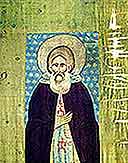 The monuments of the Moscow Principality and the early period of the Russian centralized state occupy an exceptional place in the collection. The elevated Moscow ideas were vividly expressed in Andrei Rublev art. Icon-painting greatly influenced the development of icon-embroidery at that time. The Museum possesses one of the best collections of various embroidered items. The embroidered pall with the image of St. Sergius of Radonezh, a masterpiece of Old Russian fine art, is connected with icon-painters of Andrei Rublev circle. It is a kind of medieval portrait. It was embroidered in multi-colored silks in the 1420s.
The monuments of the Moscow Principality and the early period of the Russian centralized state occupy an exceptional place in the collection. The elevated Moscow ideas were vividly expressed in Andrei Rublev art. Icon-painting greatly influenced the development of icon-embroidery at that time. The Museum possesses one of the best collections of various embroidered items. The embroidered pall with the image of St. Sergius of Radonezh, a masterpiece of Old Russian fine art, is connected with icon-painters of Andrei Rublev circle. It is a kind of medieval portrait. It was embroidered in multi-colored silks in the 1420s.
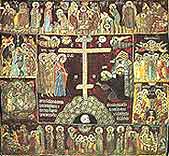 Some embroideries preserved historical inscriptions, recording memorable and sometimes dramatic events of their time. The icon-cloth “The Appearance of the Virgin to St. Sergius” reflected the tragic destiny of Grand Princess Solomonia Saburova, the first wife of Vassili III. The icon-cloth, embroidered in multicolored silks, pearls, gold and silver threads, was presented to the Trinity-St. Sergius Monastery in 1525 with a prayer for a son: “… may the Almighty God beget them with a child….”
Some embroideries preserved historical inscriptions, recording memorable and sometimes dramatic events of their time. The icon-cloth “The Appearance of the Virgin to St. Sergius” reflected the tragic destiny of Grand Princess Solomonia Saburova, the first wife of Vassili III. The icon-cloth, embroidered in multicolored silks, pearls, gold and silver threads, was presented to the Trinity-St. Sergius Monastery in 1525 with a prayer for a son: “… may the Almighty God beget them with a child….”
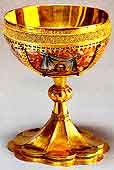 The aesthetic ideas of that time were also revealed in various works of gold- and silversmiths. The earliest works, dating back to the 14th and 15th century, are marked by a simple decoration corresponding to the tastes of that time. The signed silver reliquary cross with engraving and a stone relief icon, made by Semyon Zolotilov, was presumably commissioned by Prince Dmitry Ivanovich (Donskoi). The gold chalice with magnificent filigree on the rim of the bowl, presented to the Trinity-St. Sergius Monastery by Grand Prince Vassili II in 1449, is a masterpiece of jewelry art. On the bottom the rare inscription with the name of the craftsman runs: “And made by Ivan Fomin”.
The aesthetic ideas of that time were also revealed in various works of gold- and silversmiths. The earliest works, dating back to the 14th and 15th century, are marked by a simple decoration corresponding to the tastes of that time. The signed silver reliquary cross with engraving and a stone relief icon, made by Semyon Zolotilov, was presumably commissioned by Prince Dmitry Ivanovich (Donskoi). The gold chalice with magnificent filigree on the rim of the bowl, presented to the Trinity-St. Sergius Monastery by Grand Prince Vassili II in 1449, is a masterpiece of jewelry art. On the bottom the rare inscription with the name of the craftsman runs: “And made by Ivan Fomin”.
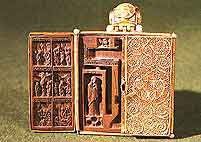 The workshop of the Trinity-St. Sergius Monastery is represented by works of an outstanding carver and jeweler of the mid-15th century Ambrose. His works are marked by a perfect composition, intricate carving, picturesque ornamental pattern. The folding icon of walnut in a gold filigree mounting, commissioned by the Monastery Hegumen Vassian Rulo, is an outstanding monument of that period.
The workshop of the Trinity-St. Sergius Monastery is represented by works of an outstanding carver and jeweler of the mid-15th century Ambrose. His works are marked by a perfect composition, intricate carving, picturesque ornamental pattern. The folding icon of walnut in a gold filigree mounting, commissioned by the Monastery Hegumen Vassian Rulo, is an outstanding monument of that period.
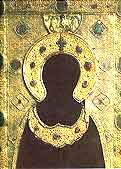 In the 16th century, Ivan the Terrible presented quite a complex of wonderful monuments. That was the time when Moscow became an All Russia cultural center and jewelry art flourished there. The best works were created by the artists of the Moscow Armory Chamber and the Trinity-St. Sergius Monastery. The bright specimens of that epoch are gold crowns and crescent collars with pendants, presented by Ivan the Terrible for “The Trinity of Old Testament” painted by Andrei Rublev. Their shape is simple, yet refined. Their decoration, combining skilful chasing, filigree and grains on gold with multicolored enamel and precious stones, is very fine. The gold mounting for the icon “St. Sergius”, made by 14 craftsmen of the Armory Chamber in the second half of the 16th century, is a remarkable work of Moscow goldsmiths.
In the 16th century, Ivan the Terrible presented quite a complex of wonderful monuments. That was the time when Moscow became an All Russia cultural center and jewelry art flourished there. The best works were created by the artists of the Moscow Armory Chamber and the Trinity-St. Sergius Monastery. The bright specimens of that epoch are gold crowns and crescent collars with pendants, presented by Ivan the Terrible for “The Trinity of Old Testament” painted by Andrei Rublev. Their shape is simple, yet refined. Their decoration, combining skilful chasing, filigree and grains on gold with multicolored enamel and precious stones, is very fine. The gold mounting for the icon “St. Sergius”, made by 14 craftsmen of the Armory Chamber in the second half of the 16th century, is a remarkable work of Moscow goldsmiths.
|


